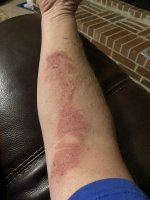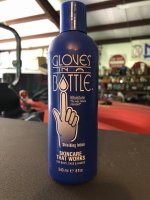Faulkner
Member
I hope no one else is as susceptible to posion ivy, poison oak, and poison sumac as I am! Every since I was a young fellow it seems I could just walk near a poison ivy vine and I'd get covered with it. Obviously, I am very observant to my surroundings and always on the watch for the plants, and realize Poison ivy rash is caused by an allergic reaction to an oily resin called urushiol. This oily resin is in the leaves, stems and roots of poison ivy, poison oak and poison sumac.
When I was about 15 years old our doctor prescribed desensitization therapy where I received a series of injections once a week for six weeks then a booster once a year. The desensitization therapy did an awesome job and, although I would still get poison ivy if exposed, the resulting ailment was more like what normal people would experience.
Because I have been so susceptible to the poison ivy rash, I've always tried to follow these tips:
Avoid the plants. Learn how to identify poison ivy, poison oak and poison sumac in all seasons.
Wear protective clothing. If needed, protect your skin by wearing socks, boots, pants, long sleeves and heavy gloves.
Remove or kill the plants. Identify and remove poison ivy, poison oak and poison sumac from your yard or garden. You can get rid of such plants by applying an herbicide or pulling them out of the ground, including the roots, while wearing heavy gloves. Afterward remove the gloves carefully and wash them and your hands. Don't burn poison ivy or related plants because the urushiol can be carried by the smoke.
Wash your skin or your pet's fur. Within 30 minutes after exposure to urushiol, use soap and water to gently wash off the harmful resin from your skin. Scrub under your fingernails too. Even washing after an hour or so can help reduce the severity of the rash.
If you think your pet may be contaminated with urushiol, put on some long rubber gloves and give your pet a bath. Daisy gets hosed down and washed if I even think she's been exposed.
Also wash as soon as possible any other items that came in contact with the plant oil — such as outdoor gear, garden tools, jewelry, shoes and even shoelaces. Urushiol can remain potent for years. So if you put away a contaminated jacket without washing it and take it out a year later, the oil on the jacket may still cause a rash.
Apply a barrier cream. Try over-the-counter skin products that are intended to act as a barrier between your skin and the oily resin that causes poison ivy rash. I have a bottle of "Gloves in a Bottle" in my truck, patrol car, duty bag, on my work bench, and in the tool box on my tractor. I use it all the time.
Unfortunately, I got careless last week and got exposed on my arm. Have no clue for sure when I did it but I wasn't "armored up" like I would have been had I realized I might be exposed. Because if all the precautions I usually take I've not had a bad bout of Poison Ivy rash in 10 years or so, but this latest rash has been a grim reminder.

This is good stuff if you want to prevent Poison Ivey

When I was about 15 years old our doctor prescribed desensitization therapy where I received a series of injections once a week for six weeks then a booster once a year. The desensitization therapy did an awesome job and, although I would still get poison ivy if exposed, the resulting ailment was more like what normal people would experience.
Because I have been so susceptible to the poison ivy rash, I've always tried to follow these tips:
Avoid the plants. Learn how to identify poison ivy, poison oak and poison sumac in all seasons.
Wear protective clothing. If needed, protect your skin by wearing socks, boots, pants, long sleeves and heavy gloves.
Remove or kill the plants. Identify and remove poison ivy, poison oak and poison sumac from your yard or garden. You can get rid of such plants by applying an herbicide or pulling them out of the ground, including the roots, while wearing heavy gloves. Afterward remove the gloves carefully and wash them and your hands. Don't burn poison ivy or related plants because the urushiol can be carried by the smoke.
Wash your skin or your pet's fur. Within 30 minutes after exposure to urushiol, use soap and water to gently wash off the harmful resin from your skin. Scrub under your fingernails too. Even washing after an hour or so can help reduce the severity of the rash.
If you think your pet may be contaminated with urushiol, put on some long rubber gloves and give your pet a bath. Daisy gets hosed down and washed if I even think she's been exposed.
Also wash as soon as possible any other items that came in contact with the plant oil — such as outdoor gear, garden tools, jewelry, shoes and even shoelaces. Urushiol can remain potent for years. So if you put away a contaminated jacket without washing it and take it out a year later, the oil on the jacket may still cause a rash.
Apply a barrier cream. Try over-the-counter skin products that are intended to act as a barrier between your skin and the oily resin that causes poison ivy rash. I have a bottle of "Gloves in a Bottle" in my truck, patrol car, duty bag, on my work bench, and in the tool box on my tractor. I use it all the time.
Unfortunately, I got careless last week and got exposed on my arm. Have no clue for sure when I did it but I wasn't "armored up" like I would have been had I realized I might be exposed. Because if all the precautions I usually take I've not had a bad bout of Poison Ivy rash in 10 years or so, but this latest rash has been a grim reminder.
This is good stuff if you want to prevent Poison Ivey


